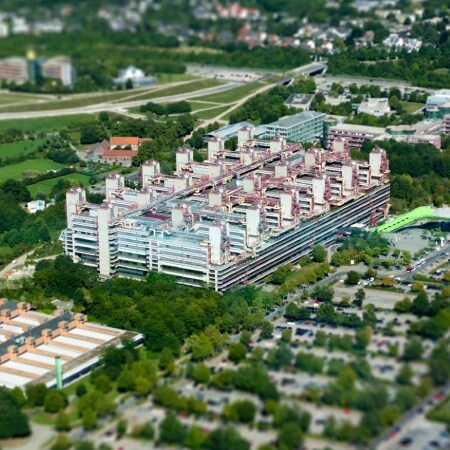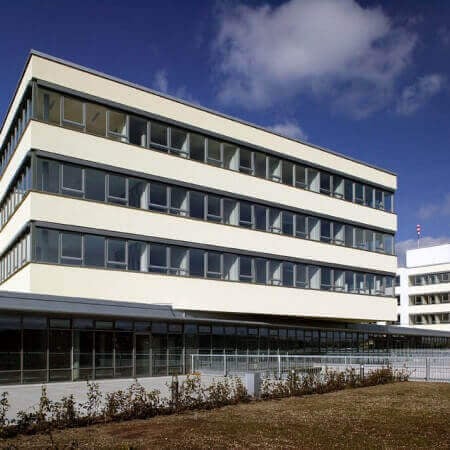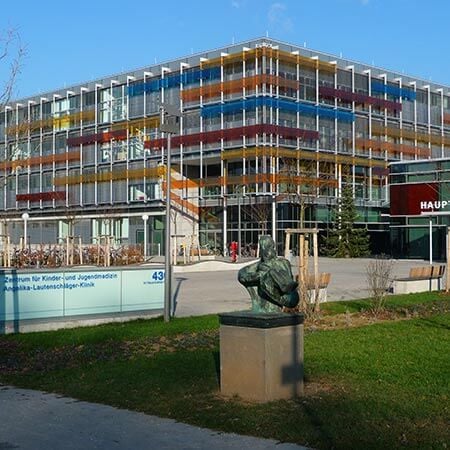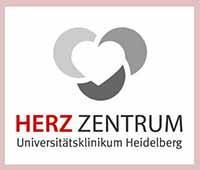A left ventricular aneurysm is a severe complication of myocardial infarction that implies a thinning of the heart muscle. The damaged muscular tissue, which has taken on blood pressure during the attack, continues to experience pressure and is unable to resume its original position.
As a result, the tissue thins and stretches, forming a bulge, an aneurysm. The left ventricle in the anterior superior region is most commonly affected.
Content
- Overview
- What causes left ventricular aneurysm?
- How is left ventricular aneurysm treated in hospitals in Germany?
- Indications for surgery
- Results of the surgical treatment
- Why undergo treatment in hospitals in Germany?
- The cost of treatment in hospitals in Germany
Overview
A cardiac aneurysm is a limited bulging of the thinning myocardial wall accompanied by a sharp decrease or complete disappearance of the contractility of the pathologically altered myocardial area. In cardiology, cardiac aneurysms are detected in 10-35% of patients who have had a myocardial infarction; 68% of acute or chronic cardiac aneurysms are diagnosed in men between the ages of 40 and 70. Most commonly, the cardiac aneurysm forms in the wall of the left ventricle, less commonly, in the ventricular septum or right ventricle. Heart aneurysm size varies from 1 to 20 cm in diameter. Impairment of myocardial contractility in the area of cardiac aneurysm includes akinesia (absence of contractile activity) and dyskinesia (bulging of aneurysm wall in systole and its recession in diastole).
The left ventricular aneurysm is difficult to diagnose because the pathology often implies a complication of diseases or (much more rarely) trauma. Patients with myocardial infarction are at risk of developing the left ventricular aneurysm. In the place where the heart is damaged, the muscle tissue thins, bulges outward under the pressure of blood, loses its contractile ability, which leads to the disturbance of blood circulation and thrombus formation. Aneurysms appear in a limited area of the anterior wall of the left ventricle, the apex of the heart, or very rarely in the lateral wall of the left ventricle.
Hemodynamic abnormalities in the left ventricular aneurysm are caused by the following mechanisms. When systolic function decreases by more than 20%, the left ventricular area is shut off from contraction. Violation of diastolic function (violation of the pressure and volume relationship) leads to a disproportionate increase in end-diastolic pressure. Due to fibrous ring dilatation or papillary muscle damage, mitral regurgitation occurs. Compensatory mechanisms in the form of myocardial hypertrophy, left ventricular cavity configuration changes and its dilatation (remodeling) lead to the progression of heart failure. Although the etiology is not precisely defined, it is suggested that it can be associated with endocarditis, cardiac lymphatic obstruction, fibroelastosis, and in some postnatal cases with myocardial infarctions associated with an anomaly of the left coronary artery branching from the pulmonary trunk. Family cases of left ventricular aneurysms have been described as well.
The pathology develops more often in elderly patients with CHD due to transmural myocardial infarction. It is dangerous with complications and consequences: development of severe heart failure, thromboembolic complications, arrhythmia, rupture of the aneurysm itself with fatal bleeding.
What causes left ventricular aneurysm?
The main cause of aneurysms is myocardial infarction.
Massive myocardial infarction destroys the structures of the muscle wall of the heart. Under the force of intracardiac pressure, the necrotic heart wall stretches and thins. A significant role in aneurysm formation belongs to the factors contributing to the increase of cardiac load and intraventricular pressure early rise, arterial hypertension, tachycardia, repeated infarcts, and progressive heart failure. The development of chronic cardiac aneurysms is etiologically and pathogenetically related to postinfarction cardiosclerosis. In this case, under the influence of blood pressure, the heart wall bulges in the area of connective tissue scar.
Congenital, traumatic, and infectious aneurysms are much rarer than post-infarction heart aneurysms. Traumatic aneurysms are caused by closed or open trauma of the heart. Postoperative aneurysms, often occurring after operations for correction of congenital heart defects (tetralogy of Fallot, pulmonary artery stenosis, etc.), can also be referred to this group.
Also, the appearance of thinning, protruding areas of tissue on the heart can be provoked by the following causes:
- Increased physical exertion over a long time.
- Persistent high blood pressure.
- Infectious diseases such as syphilis, bacterial endocarditis, and even regular inflammation of the tonsils.
- Trauma (wound to the heart, blunt trauma to the chest). This can include bullet wounds, stab wounds, falls, or car accidents.
Symptomatically, the presence of the left ventricular heart aneurysm cannot be determined, but since it causes cardiac abnormalities, it also causes general signs of cardiac activity disorder.
Clinical manifestations of acute cardiac aneurysm are characterized by weakness, shortness of breath with episodes of cardiac asthma and pulmonary edema, prolonged fever, increased sweating, tachycardia, and heart rhythm disorders (bradycardia and tachycardia, extrasystoles, atrial and ventricular fibrillation, blockages). In a subacute cardiac aneurysm, symptoms of circulatory insufficiency progress rapidly.
The clinical picture of chronic heart aneurysm corresponds to pronounced signs of heart failure: shortness of breath, syncope, resting and tension angina pectoris, feeling of heart failure; in the late stages, swelling of neck veins, edema, hydrothorax, hepatomegaly, and ascites may develop. In a chronic cardiac aneurysm, fibrous pericarditis may develop, causing the development of adhesions in the thoracic cavity.
Thromboembolic syndrome in the chronic cardiac aneurysm is represented by acute occlusion of limb vessels (often iliac, femoral, and patellar segments), brachial trunk, brain, kidney, lungs, or intestinal arteries. Potentially dangerous complications of the chronic cardiac aneurysm can be limb gangrene, stroke, renal infarction, thromboembolism, mesenteric vascular occlusion, and repeated myocardial infarction.
Chronic cardiac aneurysm rupture is relatively rare. Acute cardiac aneurysm rupture usually occurs on days 2-9 after myocardial infarction and is fatal. Clinically, a ruptured cardiac aneurysm has a sudden onset: abrupt pallor, which quickly changes to cyanotic skin, cold sweat, neck veins overflowing with blood (evidence of cardiac tamponade), loss of consciousness, and coldness in the area of extremities. Breathing becomes noisy, hoarse, shallow, and sparse. Death is usually instantaneous.
A cardiologist can diagnose the ventricular aneurysm after examining the patient and obtaining the results of all necessary tests, including ECG, ultrasound, and MRI. A timely medical diagnosis will help to avoid severe complications that are often fatal. To determine a treatment plan, doctors need to know the exact location, structure, and size of the aneurysm.
How is left ventricular aneurysm treated in hospitals in Germany?
Surgical treatment of postinfarction left ventricular aneurysms in patients with coronary heart disease can significantly improve the prognosis and clinical course of the disease, increase the quality of life and its duration.
Even though over the last 50 years the hospital mortality rate has halved due to the improvement of surgical techniques, it remains high. The choice of the method of left ventricular aneurysm management is determined by the localization of the lesion, depending on which one eliminates different areas of left ventricular asynergy and restores its shape.
Today, it is not possible to judge reliably the advantages of one type of technique of reconstruction over the other. Risk factors of in-hospital mortality are age, incomplete myocardial revascularization, certain cardiac risk groups, previous emergency surgery, and ejection fraction less than 30%. To improve clinical outcomes, doctors strive to create a left ventricular shape close to physiological ones and minimize the negative impact of the intervention on myocardial contractile function.
Due to a relatively favorable prognosis in asymptomatic left ventricular aneurysms, indications for surgical treatment in such patients are relative. Nevertheless, in patients indicated for surgical myocardial revascularization (CABG), surgical restoration of the correct left ventricular shape should be performed in some cases.
With a proper professional approach, careful study of LV function according to EchoCG data, assessment of aneurysm shape and localization, ejection fraction of contracting (surviving) part of the LV, the surgery to remove the left ventricular aneurysm is quite justified, since subsequently the LV wall stress is reduced, muscle fibers are again directed to the right side, the systolic and diastolic function of the LV is improved.
Relative contraindications for surgery in patients with left ventricular aneurysms are extremely high risk of anesthesia, absence of functional myocardium outside the aneurysm, and low cardiac index.
In the surgical treatment of LV aneurysm, standard access by median sternotomy is performed. The circulatory apparatus is connected as for CABG, and LV drainage through the right pulmonary veins is set for convenience. After cardioplegia, the aneurysm site looks like a whitish, fibrous area embedded into the left ventricular cavity. An aneurysm incision is made along the anterior descending artery, at least 1,5 cm from it. The thrombus existing in the cavity is removed, excluding even very small fragments.
Such surgical procedures are often accompanied by intervention on the mitral valve, as well as a bypass of the anterior descending artery and other arteries if indicated. Having assessed the volume of the resected area, remodeling and restoration of LV structure are started. After completing the surgical manipulations on the heart, the important process of expulsion of air from the heart cavities is performed, followed by blood flow to the heart by removing the clamp from the aorta, and after a couple of minutes, the restoration of cardiac activity takes place. The end of the artificial ventilation session for the operated LV can be a real challenge and require the use of specific drugs, as well as intra-aortic balloon counterpulsation.
Indications for surgery
Surgical treatment is indicated in patients with LV dysfunction with areas of akinesia and dyskinesia of its walls and a regular increase in LV volume, as well as in case of threatened aneurysm rupture and thromboembolic syndrome in thrombosed aneurysms.
Thus, absolute indications for surgery include:
- Anteroseptal infarction and left ventricular dilatation.
- Decreased ejection fraction (even below 20%); regional left ventricular asynergia (dyskinesia or akinesia) greater than 35% of the ventricular circumference.
- Presence of symptoms of angina, heart failure, arrhythmia, or their combination.
- Induced ischemia during tests in asymptomatic patients.
The patients without symptoms and negative results of provocation tests should be monitored by echocardiographic examinations every 6 months. If there is a tendency for decreased ejection fraction and left ventricular dilation, surgical treatment should be recommended for such patients.
Relative contraindications for left ventricular reconstruction in left ventricular aneurysm are:
- Systolic pressure in the pulmonary artery of more than 60 mm Hg (not associated with marked mitral regurgitation).
- Pronounced right ventricular dysfunction.
- Regional asynergia without ventricular dilatation (risk of the reduced left ventricular cavity).
Results of the surgical treatment
A frequent complication after LV aneurysm surgery is a mild ejection syndrome, which develops due to excessive reduction of LV cavity size, as well as ventricular arrhythmias and pulmonary insufficiency. However, if the operation is performed correctly, as a rule, positive effects are observed in the long-term postoperative period. LV function, ejection fraction, and exercise tolerance improve. Angina and heart failure risks decrease. The 5-year survival rate of patients reaches 80%, and 10-year is about 60%.
The prognosis of the disease has not yet been elucidated due to the rarity of the pathology. Nevertheless, it seems that untreated ventricular aneurysm has a progressive nature with the subsequent unfavorable course. The majority (60%) of patients with a symptomatic course of this disease eventually develop heart failure. Other complications are rare and include thrombosis, coronary insufficiency, arrhythmias, subacute bacterial endocarditis, and angina pectoris. The prognosis for the fetus with the left ventricular aneurysm depends on the time of detection, the size and progression of the aneurysm, the presence or absence of fetal lung compression, the involvement of mitral valve opening, and the presence of myocardial injury.
Why undergo treatment in hospitals in Germany?
Because today there is a high incidence of cardiovascular pathology and heart disease ranks first in the mortality rate indicators, cardiac surgical manipulations are very popular. And while 50 years ago heart surgery was a rarity, today in modern cardiac surgery clinics such patients can be successfully treated and rehabilitated.
Performing any cardiac surgical intervention requires high qualification, many years of practice, and experience. The cardiology hospitals in Germany are well known for their specialists, as well as their state-of-the-art equipment. Doctors with world renown, excellent skills, and thousands of grateful patients perform dozens of heart and vascular surgeries every day.
If you are considering the option of treatment in Germany, contact Booking Health for more information.
The cost of treatment in hospitals in Germany
The cost of treatment and various medical services in hospitals in Germany are among the significant factors that attract patients along with the high quality of treatment in Germany. Here are some examples of prices for medical services:
- The prices for left ventricular diagnostics start at 500 EUR.
- The cost of treatment with CABG and plastic repair starts at 9,814 EUR.
- The prices for rehabilitation in German hospitals start at 566 EUR.
If you want to know the cost of treatment in Germany in your clinical case, contact Booking Health.
Booking Health also provides useful services that help to make your treatment of left ventricular aneurysms in Germany as comfortable as possible. Do not hesitate to fill in the request form on the Booking Health website for extended info.
Authors: Dr. Nadezhda Ivanisova, Dr. Sergey Pashchenko




















